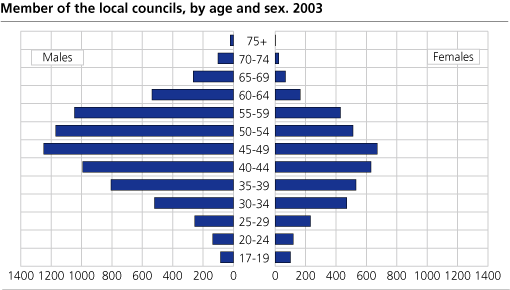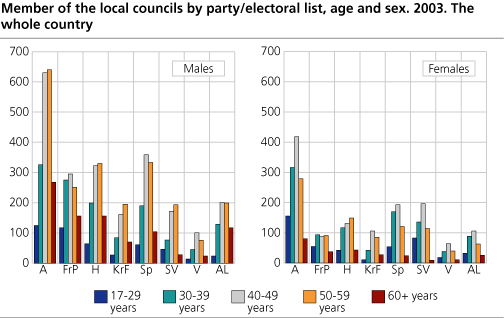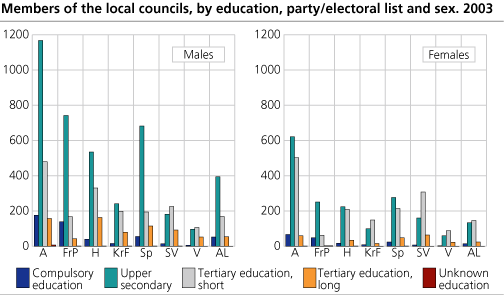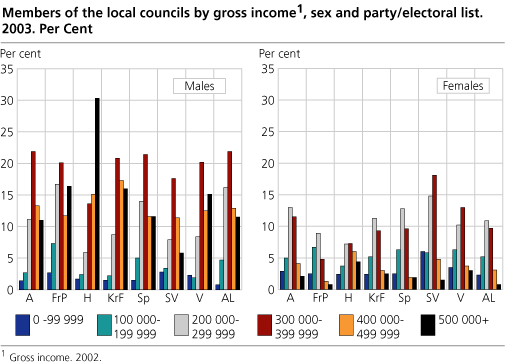Content
Published:
This is an archived release.
High gross income and education in Municipal Councils
One third of the members of the municipal council are between 40 and 49 years old. The age and the higher education are related to higher gross income than for the rest of the population. The percentage of non-western country background was low. Half of the members of the municipal council are re-elected and most of them are men.
As shown in the figure there is a skewed age distribution. There are very few women older than 60 years, and few men younger than 30. Most of the chosen members, one third, are between 40 and 49 years old.
The members of the Labour Party had en average sex and age distribution compared to the other members. The members of the Socialist Left Party have the highest percentage of women less than 60 years old. The members of the Conservative Party have most men older than 40 and women between 50 and 59 years old. The Christian Democratic Party have least young women and most men and women older than 50. The Centre Party has the highest percentage of men between 40 and 60. The Liberal Party has the highest percentage of men and women between 40 and 49 years old. The Progress Party highest percentages are of men between 30 and 49, and older than 60.
Country background
597 members of the municipal council with non-Norwegian background were chosen. It represents 5.3 per cent of the total. 472 of these members were from western countries and 125 from non-western countries. The immigrant population by 1 January 2003 was 7.3 per cent of the total population, and 5.3 per cent of them had non-western background. The percentage of members of the municipal council from non-western countries was 1.1 per cent. Two in three with non-western background were chosen from the lists from the Labour Party and the Socialist Left Party.
Eight in ten were employed
The majority of the members of the municipal council were employed. Only 13 per cent were self-employed. In the Centre Party one in four was self-employed, usually in business related to agriculture and farming. Half of the chosen members that work in agriculture, forestry and fishing represented the Centre Party.
Four in ten had higher education
The majority of the members of the municipal council had upper secondary education as highest education. One in three had tertiary education, short. 9 per cent had University tertiary education, long. The percentage of members with only compulsory education is much lower than for the rest of the population. The percentage of members with upper secondary is lower and the percentage with higher education than upper secondary is much higher.
Eight in ten members of the Progress Party have only compulsory education or upper secondary. This percentage is 6 in 10 for the Centre and Labour Parties and one in two for the Conservative and the Christian Democratic Parties. One in three from the Socialist Left and the Liberal Parties have upper secondary or lower education. In the Liberal, the Socialist Left and the Conservative Parties had respectively 17, 15 and 13 per cent of the chosen members tertiary education.
Half of the members of the municipal council from the Socialist Left Party had lower tertiary education. This rate is 45 per cent for the Liberal Party, four in ten for the Christian Democratic Party, and one in three for the Conservative and the Labour Parties.
Income
The gross income of the members of the municipal council was quite different from the rest of the population. There were less who earned less than 200 000 NOK, and the percentage that earned between 200 000 NOK and 299 000 NOK was lower than for the average Norwegians. The chosen members had a much higher percentage of income of 300 000 NOK or higher. Almost one in three chosen men from the Conservative Party and the Progress Party earned 500 000 NOK or more. The income is often related to the age and the education.
The Conservative Party and the Christian Democratic Party lost one in three chairmen.
Both Conservative Party and Christian Democratic Party lost chairmen in the municipal council and county election in 2003. These parties lost almost one of three chairmen in their lists compared to the municipal council election in 1999. The Progress Party and the Centre Party got most new chairmen, 12 more than four years ago. The Socialist Left Party and the Liberal Party got seven more chairmen, even though one party won votes in these elections and the other one lost votes. The Socialist Left and the Labour Parties have together more than 41 per cent of the chairmen of the country, that is 3 per cent more than in last municipal council election. The Conservative, the Christian Democratic, the Centre and the Liberal Parties got 204 chairmen, 47 per cent, while they got 53 per cent in 1999 and 59 per cent in 1995.
Local lists got 26 chairmen, 6 chairmen were chosen from common lists of two or more parties, and 6 were chosen from list where registered parties collaborated with unregistered parties (See About the Statistics).
35 chairmen in the municipal council election were chosen directly, this is 16 more than in the election in 1999.
The Socialist Left Party got most new deputy chairmen.
The Socialist Left Party got 39 new deputy chairmen. This party increased most the number of deputy chairmen. The Progress Party doubled the number of deputy chairmen to 40. On the other hand, the Christian Democratic Party lost 29 deputy chairmen, 46 per cent less than in 1999. The Conservative Party lost almost one in four deputy chairmen. The Labour Party lost 13, and got a total of 108 deputy chairmen. The Liberal Party had double number of deputy chairmen than chairmen.
17 per cent of female chairmen
The chairmen election resulted in 17 per cent female chairmen. This is only 8 per cent more than in 1999. The Labour Party had 33 per cent, the Centre Party had 16 per cent and the Progress Party had no women chairmen. The Conservative Party lost 11 female chairmen compared to 1999.
There are no changes for female deputy chairmen. As in 1999 there is double number of female deputy chairmen than chairmen. One third of these female deputy chairmen were from the Labour Party. The Socialist Left Party had 21 per cent and the Centre Party had 17 per cent female deputy chairmen.
Tables:
- Table 1 Chairmans by party1 at the Municipal Council Election 2003. County
- Table 2 Deputy chairmans by party1 at the Municipal Council Election 2003. County
- Table 3 Municipalities, by party1, chairman and deputy chairman. 2003. The whole country
- Table 4 Chairmans by party1 at the Municipal Council Election 2003. Females. County
- Table 5 Deputy chairman, by party1 lists at the Municipal Council Election 2003. Female. County
- Table 6 Municipalities with direct election of chairman
- Table 7 Members, re-elected members and deputy members of the local councils. 2003. County
- Table 8 Members, re-elected members and deputy members of the local councils, by sex and party/electoral lists. 2003
- Table 9 Chairman and deputy chairman of the county councils. Name and party1 at the County Council Election 2003. County
- Table 10 Members and re-elected members of the executive commitee of local councils, by sex and party/electoral lists at the Municipal Council Election 2003
- Table 11 Members and re-elected members of the executive committee of local councils. 2003. County
- Table 12 Members of the executive committee of county councils, by party1 at the County Council Election 2003. County
- Table 13 Deputy members of county councils, by party1 at the County Council Election 2003. County
- Table 14 Members of county councils, by party1 at the County Council Election 2003. County
- Table 15 Members and re-elected members, by sex and party/electoral list of the executive committee of county councils 2003
- Table 16 Members of the executive committee of the county concils and re-elected members. 2003. County
- Table 17 Members of the executive committee of local councils, by parti at the Municipal Council Election 2003. Municipality (figures were corrected 2 July 2004)
- Table 18 Members of the local councils, by party1 at the Municipal Council Election 2003. Municipality (figures were corrected 2 July 2004)
- Table 19 Chairmans/deputy chairmans 2003. Spesification of Joint lists (FL), Local list (LL) and Other lists (AL)
- Table 20 Members and re-elected members, by sex and party/electoral list of the County councils 2003
- Table 21 Members of the County concils and re-elected members. 2003. County
- Table 22 Member of the local councils, by party/electoral list, age and sex. 2003. Per Cent. The whole country
- Table 23 Member of the local councils, by age and sex. 2003. The whole country
- Table 24 Member of the local councils, by age, sex and county. 2003. Per Cent
- Table 25 Member of the county councils, by age and sex. 2003. The whole country
- Table 26 Members of the local councils, by industri, sex and region. 2003. Per Cent
- Table 27 Members of the local councils, by party1, industri and sex. 2003. Per Cent
- Table 28 Members of the local councils by, level of occupation, sex and region. 2003
- Table 29 Members of the local councils by, party1, level of occupation and sex. 2003. Per Cent
- Table 30 Members of the local councils, by country background and region. 2003
- Table 31 Members of the local councils, by country background and party1. 2003
- Table 32 Members of the local councils, by education, party1 and sex. 2003
- Table 33 Members of the local councils, by education, party1 and sex. 2003. Per Cent
- Table 34 Members of the local councils by education and and sex. 2003. Region
- Table 35 Members of the local councils, by education, sex and region. 2003
- Table 36 Members of the local councils by gross income and sex. 2003. Region
- Table 36.a All the persons older than 17 years, by gross income. Per cent
- Table 37 Members of the local councils by gross income, sex and party/electoral list. 2003. Per cent
- Table 37.a All the persons older than 17 years, by gross income. Per cent
This page has been discontinued, see Municipal and county council election, candidates and representatives, Every four years, candidates.
Find more figures
Find detailed figures from Municipal and county council election, candidates and representatives
Contact
-
Øyvin Kleven
E-mail: oyvin.kleven@ssb.no
tel.: (+47) 45 88 89 37
-
Statistics Norway's Information Centre
E-mail: informasjon@ssb.no
tel.: (+47) 21 09 46 42
-
Tove Bergseteren
E-mail: tove.bergseteren@ssb.no
tel.: (+47) 99 79 08 19




